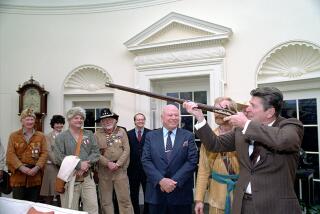Big government-small government debate distorts history
- Share via
Every four years Americans are presented with different visions of the future and are asked to choose between them. This year, we’ve been told, the choice is between two conceptions of government: small versus big. The Republican presidential ticket of Mitt Romney and Paul Ryan has promised to “restore” America to its “small government” past.
Any vision of the future is built upon a certain understanding of the past. Although past and future are inextricably linked, we spend much less time evaluating candidates as historians than we do assessing their skills as fortunetellers able to predict the future.
As historians, Romney, Ryan and the rest of the GOP insist that the federal government is the mortal enemy of the private sector, and that government only functions to impinge on the freedoms of the people. “Individual initiative made the desert bloom,” said Barry Goldwater, godfather of the New Right of the 1960s.
It may be a rousing narrative of the past, but it isn’t really true. From the very beginning of this nation, the federal government has worked in partnership with business and with other sectors of society to make this a better, more prosperous country.
Take, for starters, the communication and transportation networks without which our economic growth would not have happened. The federal government saw the need for those innovations as early as 1792 when Congress passed the Postal Act, which enabled postal routes to expand into the hinterlands, allowed newspapers to travel through the mail and established privacy in the mail as a civic ideal. In other words, it made the 1st Amendment work and created a mechanism for information to flow across the nation.
In 1862, Congress chartered the Union Pacific Railroad to connect both coasts, making the transport of people and goods across the continent faster and more efficient. Across the rest of the 19th century, the federal government promoted railroad construction by giving away land in the West to railroad corporations, which financed their tracks by selling off some of the land. Without those federally subsidized railroads, the West would never have developed economically as it did.
Also in 1862, Congress passed the Morrill Land Grant Act, certainly among the greatest federal-state collaborations in our history. By providing the states with land that in turn could be used as a revenue source, the federal government enabled states to establish the great public universities.
In turn, those universities have provided democratic access to education that would have been impossible otherwise, especially after the GI Bill made federal money available for even more young people to attend. For 150 years, the graduates of those government-subsidized universities — from farmers and engineers to doctors and lawyers and more — have contributed immeasurably to our society.
And so it has gone across a wide spectrum of American life. Homeownership is a centerpiece of the “American dream” only because the federal government has facilitated homeownership for millions since the 1930s through various programs. If you aren’t worried about getting malaria when you visit the American South, that’s because federal public health initiatives effectively eradicated the disease from that region in the first half of the 20th century. It would be hard to imagine the “Sun Belt” boom if people there were still swatting malarial mosquitoes.
As for Goldwater’s desert, he forgot to mention that without the Newlands Restoration Act of 1902, which provided money for massive irrigation projects across the West, little would have bloomed there.
This is the history that the current GOP has ignored, denied or perhaps never learned in the first place. But their historical misunderstanding runs even deeper. The point is not that the “government” undertook these initiatives. We did.
We are, as the first Republican president put it in 1863, a “government of the people, by the people, for the people.” The policies and programs pursued by the federal government are nothing more than the actions taken by our elected representatives to carry out our common objectives and express our shared ideals. Ever since the Postal Act of 1792.
To honor and “restore” our American tradition means recognizing that the federal government has always complemented the private sector to move this country forward.
Steven Conn, a professor of history and director of the public history initiative at Ohio State University, is the author of the forthcoming book “To Promote the General Welfare: The Case for Big Government.”
More to Read
A cure for the common opinion
Get thought-provoking perspectives with our weekly newsletter.
You may occasionally receive promotional content from the Los Angeles Times.










